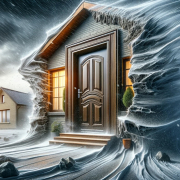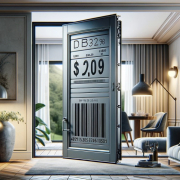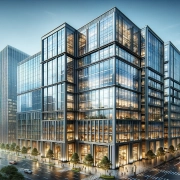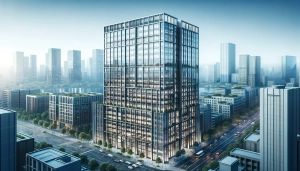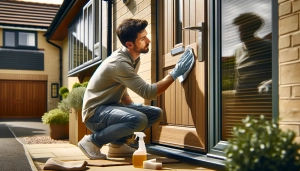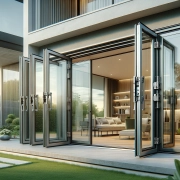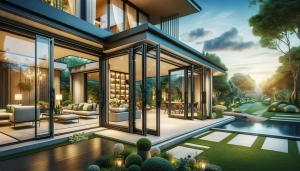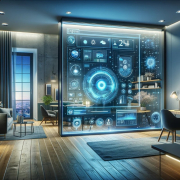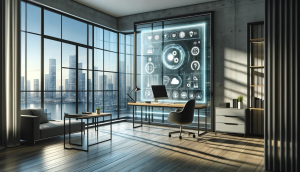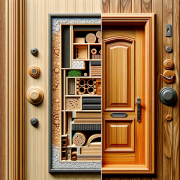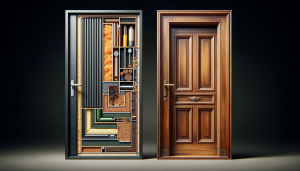Custom Bi-folding Doors
Enhancing Home Dynamics with Custom Bi-folding Doors
Table of Contents
When it comes to transformative home improvements, custom bi-folding doors are a feature that combines functionality with aesthetic appeal. These innovative doors not only enhance the accessibility and flow of living space but also bring a modern flair that can be tailored to any homeowner’s taste, effectively bridging indoor and outdoor spaces for a seamless and expansive living experience.

Design Considerations for Custom Bi-folding Doors
Assessing Space and Size Requirements
Before embarking on the journey of installing bi-folding doors, it’s crucial to understand the spatial dynamics they will occupy. These doors are ideal for both expansive and compact spaces, offering flexibility with a variety of opening configurations. The key is to consider how the doors will fold and stack when open, ensuring they harmonise with the existing space without hindrance.
Choosing the Right Material
Materials play a significant role in the functionality and longevity of bi-folding doors. Aluminium, with its strength and slim profile, allows for maximum glass and minimal frame, while timber adds a warm, natural element to a home. UPVC is a cost-effective option that provides good thermal performance and is available in various finishes to mimic other materials.
Style and Aesthetic Compatibility
The design of custom bi-folding doors should complement the architectural style of the home. Whether you’re looking for a sleek, contemporary look or a more traditional feel, the door style, colour, and details can be tailored to enhance your home’s character. The transformative power of these doors is not just in their function but in their ability to integrate seamlessly with your home’s design ethos.
The Mechanics of Bi-folding Doors
Understanding the Folding and Sliding Mechanism
The beauty of bi-folding doors lies in their unique mechanism, which allows them to fold neatly and slide effortlessly to the side, creating a wide-open space. The precision-engineered tracks and runners facilitate a smooth transition, which is central to their design.
The Role of High-Quality Hinges and Bearings
To ensure longevity and consistent performance, the quality of hinges and bearings in bi-folding doors cannot be overstated. They bear the weight and provide the flexibility needed for the folding action, making high-quality hardware an essential component of a well-functioning system.
Ensuring Smooth Operation and Functionality
The true test of well-designed bi-folding doors is in their operation. A door that opens smoothly and closes securely without effort is a hallmark of quality. Regular checks and maintenance will ensure that the mechanisms continue to operate at their best, providing ease of use for years to come.
Customisation Options for Bi-folding Doors
Colour and Finish Customisation
Customisation is at the heart of personalisation, and with bi-folding doors, the options are endless. From bold colors that make a statement to subtle shades that blend with your décor, the choice of finish can significantly impact the overall look of the doors, and adding textures or even bespoke designs can further tailor the doors to reflect your unique style and home character.
Glass and Glazing Choices
The glass you choose is just as important as the frame. Options range from double glazing for improved thermal efficiency to tinted or frosted glass for privacy, and increasingly, smart glass options are available, allowing for adjustable transparency or shade for further control over privacy and light. Some homeowners opt for low-emissivity (low-E) glass to reduce UV rays and protect interior furnishings from sun damage.
Hardware and Accessory Selection
The finishing touch to any set of bi-folding doors is the hardware. Handles, locks, and hinges can be chosen to match or contrast with the door itself, offering not only an opportunity to customise every detail to your preference but also to enhance functionality and security according to individual needs and styles.
Thermal Efficiency and Insulation
Insulation Materials and Energy Efficiency
The construction of bi-folding doors offers more than just aesthetic benefits; they are a bastion of energy efficiency. With the right materials and installation, these doors can create a thermal barrier that reduces heat loss in winter and keeps your home cooler in the summer.
Weatherproofing and Sealing Techniques
Effective weatherproofing is essential, especially in the unpredictable UK climate. Bi-folding doors are designed with seals and weatherstrips that prevent drafts and water ingress, ensuring that your home remains comfortable whatever the weather.
Impact on Heating and Cooling Costs
With energy prices on the rise, efficient insulation is more important than ever. Bi-folding doors with high-performance glazing can help to minimize heating and cooling costs, making them a smart choice for environmentally conscious homeowners, and incorporating features like thermal breaks and weather seals can further enhance their energy-saving capabilities, contributing to a more sustainable and cost-effective home environment.
Safety and Security Features
Locking Systems and Multi-Point Locks
Safety is paramount, and custom bi-folding doors come equipped with sophisticated locking mechanisms. Multi-point locks that engage at several points along the door frame are a standard feature, providing heightened security and peace of mind. These locks are not just about deterrence; they are about creating a secure environment for you and your family.
Glass Options for Enhanced Security
The glass in your bi-folding doors can be just as secure as the frames. Options like toughened or laminated glass are harder to break, offering an additional layer of security. These choices don’t compromise on aesthetics and can be tailored to meet both your safety and design requirements.
Compliance with Safety Standards and Regulations
In the UK, adherence to building regulations and safety standards is non-negotiable. Custom bi-folding doors are designed to meet these stringent requirements, ensuring that they not only look good but are also safe and secure.
The inclusion of custom bi-folding doors in your home can revolutionise the way you interact with your space. They are not just a door but an investment in the comfort, functionality, and beauty of your home. With their vast customisation options, you can ensure that they perfectly match your aesthetic and practical needs. Their robust security features and energy-efficient design also make them a smart choice for the environmentally and safety-conscious homeowner. By choosing custom bi-folding doors, you are choosing a lifestyle—open, secure, and seamlessly connected to the outside world.


